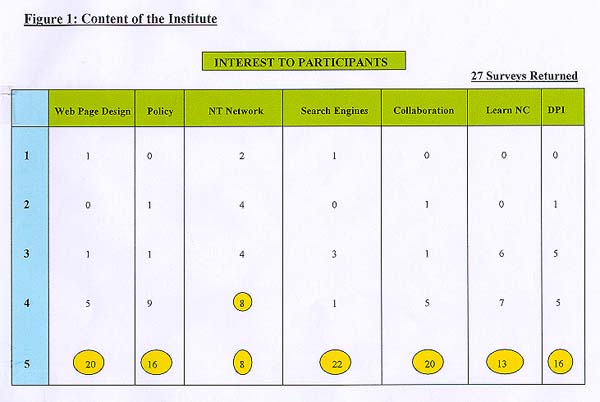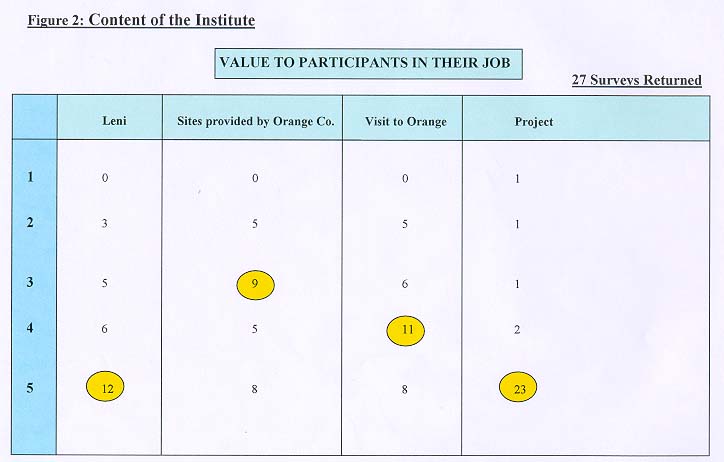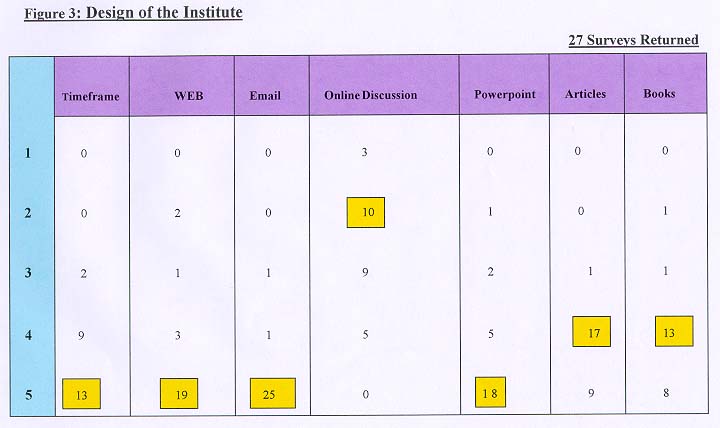
Draft Schedule of Events
[About the Institute]
[List of participants]
[March 1998 curriculum]
[June 1998 curriculum]
[June Photos]
[Evaluation of June Workshop]
[October 1998 curriculum]
[Photos of the October Workshop]
[More Photos of the October Photos]
[Internet Presentations by Participants]
[Online Resources]
[Final Evaluation
Final Evaluation of the Internet Institute
"The Institute gave us the nuts and bolts of just about everything.
Now we have the opportunity to be the 'screwdriver'....and put it all together."
CONTENT
"The breadth and depth of what they covered was incredible."
[High School Technology Teacher]
Participants rated the content of the Institute high, both in terms of its interest
to them and its value in their jobs (see Figure 1 and 2). For some
of the participants all of the topics were new. For others the content was not new,
however, the Institute gave them the opportunity to talk at length with
experts, to have their questions answered, and to learn how other schools across
the state are dealing with issues involving Internet use. Two of the participants
described it this way: "Our system has moved slowly toward Internet access.
We haven't had professional development. Contractors come during the
night and there is no one to explain to us what they have done. The Institute
helped us get answers to questions-to understand the technical
aspects of Internet access and to begin to think about how to use it
in instruction." "[The Institute] gave me access to people I
haven't talked to before. I could get ideas and ask questions. It allowed me
to put things together-to syntesize."
DESIGN
"This was one of the best professional development experiences I've ever had."
[Middle School Technology Teacher]
The Institute modeled what we know about quality professional development. It focused on concrete
classroom applications and exposed participants to actual practice
rather than to descriptions of practice. It included opportunities
for group support and collaboration and it provided opportunities
for participants to reflect on what they were learning.
Participants responded favorably to all aspects of the design (see Figure 3).
Three design elements seemed to make this workshop "better" than
other workshops they attended: (1)the requirement for them to come
as a team, (2)the timeframe for the workshop, and (3)the opportunity
for discussion. Participants felt these design elements enabled them to develop
a deeper understanding of the content and to internalize what they
had learned.
"Having to come as a team was important.
When you don't go alone, you learn more. In a group of two each hears
something the other person didn't hear. We picked up different
things because we had different backgrounds."
The time frame was perfect. It gave us a chance to
come back to school and try things out and then come back to
UNC and ask questions and share what we had done."
"At most conferences or workshops you have 'canned'
presentations for 30 or 40 minutes nad then you move onto the
next presentation. You don't have time to talk about issues
or to connect with the presenters and other people in the group.
At this workshop, we had the opportunity to ask questions and have our
questions answered."
Other design elements that were mentionned as important:
- Requiring teams to complete a final project.
- Providing opportunities for the participants to meet informally in the evenings.
- Requiring teams to apply for the Institute.
INSTRUCTORS
"They had the best people doing the
sessions."
[High School Technology Teacher]
The instructors for the Institute were knowledgeable about the
content and about good teaching practice. The participants saw them
as "experts" in the field and felt fortunate to have an opportunity
to learn from them. According to one participant, "I was really impressed
that they took the time to talk to us-people of their capacity."
The instructors also modeled good teaching practice. They built on
the participants prior knowledge, related the content to the participants
needs and interests, included opportunities for practice, and provided
opportunities for the participants to reflect.
The participants, however, were most impressed by the instructors'
willingness to treat them as professionals-to talk to them as
knowledgeable people and colleagues. According to one of the
participants, "The best thing was that we were treated professionally.
After the sessions I felt refreshed, respected, and challenged."
SUGGESTIONS
The following suggestions are based on the surveys and interviews:
- Include a panel discussion that allows technology and school
library media personnel from central office to discuss issues
related to Internet use and to answer questions raised by school
technologists and school library media specialists working at the
building level.
- Include homework throughout the Institute.
- Provide an opportunity for school library media specialists
and school technologists to discuss their roles, to talk about
ownership and control issues, and to develop strategies for
helping teachers and administrators understand the importance
of both people to the success of the students.
- Continue statewide relationships that have developed as a
result of this workshop. Ideas: (1)continue electronic communication and (2)
sponsor a reunion.




Comments about Content of the Institute:
- We got the nuts and bolts of just about everything.
Now, we have the opportunity to be the "screwdriver,"
work at it and put it all together to effectively and
efficiently collaborate with others across the school,
county, region, and state.
- Being together with other media people, technologists,
network groupies, DPI folks, and other presenters was of
tremendous value in providing insight into issues facing our
schools, our job descriptions, our expectations for the future
responsibilities.
- Exposure to all was challenging, inspiring, rejuvenating!
- Well-organized and integrated content. On target for the needs of the group.
- Very valuable content! I've learned a lot and it gave me so
many ideas to bring to other projects for the web and to integrate
into the curriculum.
- I learned a lot and it gave me so many ideas to bring to
other projects for the web and to integrate into the curriculum.
- I needed this professionally. The opportunity came at the
right time for me and I learned a great deal. I also know
now what I still need to learn, the difference is, I have allies
and resources now.
- Very relevant to areas that I am constantly learning about.
- This has been a virtual candy store.
- The Institute was well-planned and executed-the leaders went out of their
way to help answer our questions and adjust the direction
of the training.
- [The project allowed me] to use what I had been exposed to and add even more understanding.
- Great experience-We were treated as professionals!
- Invaluable resource people and contacts.
- All the pieces fit together in the end.


Comments about the Design of the Institute
Team Approach
- The variety of the backgrounds of the participants was fascinating.
- Coming as team has increased awareness of other job areas and created more collaboration-It made us more of a team at our school.
- The team approach showed us that as a team we could create a project-that we come from different backgrounds doesn't matter.
- Having partners was wonderful so we could go back and collaborate.
- We really need a reunion to keep us on task and hold us accountable for continuing our projects.
- Overall we are now a state-wide team-we know faces and can readily communicate and share.
- Even though as participants we seemed to be "individualistic", we were able to feed off of our differences to fit our needs.
- It was wonderful how the instructors' content meshed so well.
Instructional Strategies
- You provided well-planned, time-efficient hands-on opportunities that were meanignful.
- The project challenged us and pushed us onward.
- I felt like we needed to revisit some topics, like graphics.
- The variety kept it "spicy."
- Hands-on was by far the most helpful in retaining the information.
- Good variety of activities.
- Having to complete a project made us internalize and practice all the technical "stuff" we heard about.
- Hands-on and discussions were the best ways for me to learn.
- Excellent balance of methodology.
Time Frame
- The extended time frame was a perfect arrangement; 10 days was a necessity.
- I appreciated the design, although 3 day sessions would have been better than 2 days.
- Effective and efficient use of our time, not a moment wasted not even at breaks or meals.
- Next time structure time to include more practice.
Electronic Communication
- Very appropriate methods.
- Email was a great way to communicate.
Materials
- Powerpoint made the long sessions interesting and easy to absorb.
- Just the nature of Powerpoint gets old.
- More articles, books, and URL's!!!!
- Lots of great and valuable "junk" and I did read it all!!!







